Supply Chain Quiz 2
1/64
There's no tags or description
Looks like no tags are added yet.
Name | Mastery | Learn | Test | Matching | Spaced |
|---|
No study sessions yet.
65 Terms
Legal Forms of Transportation (4)
Transportation service companies are classified
legally as either common, contract, exempt, or
private carriers
Common carriers
Contract carriers
Exempt carriers
Private carriers
Common Carriers
offer transportation services to all shippers at published rates between designated locations without discrimination.
Ex: Airlines (like Delta or American Airlines)
Bus companies (Greyhound)
Railroads/Amtrak
Shipping companies (FedEx, UPS, USPS)
Taxi services or ride-share drivers in many states
Contract Carriers
not bound to serve the general public. Contract carriers serve specific customers under negotiated contractual agreements.
Ex: A private trucking company that hauls products exclusively for Coca-Cola
*coke does not own the trucks! this is the difference between this and private
Exempt Carriers
exempt from federal economic regulation of services & rates & if they transport certain exempt products like unprocessed produce, livestock, coal, school buses
Private Carrier (air transportation)
not subject to economic regulation & typically transports goods for the company owning the carrier.
Ex: Walmart using its own trucks to deliver products to its stores.
*Walmart owns these trucks! thats the difference between this and contract
Where do airlines make most of their money?
Airline industry is very dependent on passenger revenue to maintain financial viability:
Passenger fares represents about 75% of revenue
Private
transport company’s freight and personnel in support of the primary business
For Hire carriers
businesses that transport passengers or cargo for compensation
Major Carriers
provide services between major population areas (New York, Chicago, Los Angeles, Miami, etc.)
Ex: United, Delta, Southwest,
American Airlines, US Airways, Alaska Airlines, AirTran
Majors are responsible for majority of passenger and freight activity
Major carriers do provide cargo transportation together with passengers
On passenger planes, cargo is being held in the “belly hold” under the passenger cabin
Cargo is typically consolidated into pallets
National Carriers
provide services between less- populated areas and major population centers
routes are relatively short
Examples of national carrier airlines: Frontier, Airlines, Midwest Express, jetBlue
Ex: JetBlue: Albany, NY → Boston, MA
Albany is smaller, Boston is a major hub. Short route, narrow-body jet.
Regional Carriers
Similar to National because they do short routes
Routes served are usually relatively short with smaller planes
They “feed” passengers from outlying areas to major airports served by majors
Operate within a particular region of the country
Examples of national carrier airlines: Piedmont Airlines, Atlantic Coast Airlines, Sky West Airlines
Ex: Atlantic Coast Airlines: Norfolk, VA → Washington D.C. (Dulles)
All Cargo Carriers
Transport Primarily Cargo
Examples: FedEx and UPS airlines, DHL (German logistics company), Atlas Air, Air Transport International
In 1977 cargo transportation was deregulated,
allowing all-cargo carriers to freely set the fees
and rates, enter and exit markets, and use any
size airplanes dictated by the market needs
Charter Carriers
transport people and freight
Use small- to medium-sized aircrafts
Have no set time schedule or designated route
Carrier charters the entire aircraft to transport people of freight between specified origin and destination
Big customer for charters is Department of
Defense (personnel and supplies)
Main Advantages/Disadvantages of Air transportation
Advantages:
Air transportation service is fairly reliable (except in adverse weather conditions)
Variations in transit times are small, flights are usually arriving on-time (+/- 15 min of scheduled time)
fast
Disadvantage:
poor accessibility
Passengers/cargo must be transported to/from airport, there is no door-to-door air delivery
It adds time and cost to the air services
expensive
Cost of Air tansportation
Most Expensive relative to other (surface) modes but fast
low transit time between given points
Cost of air transportation is
about 3 times higher than for motor carriers (trucks)
about 10 times higher than for rail
Hub-and-spoke sytem
Most air carriers use a hub-and-spoke system, routing flights through major hubs for connections.
Major hubs examples:
Delta: Atlanta, Cincinnati
United: Chicago, Denver, Washington-Dulles
American: Charlotte, Chicago, Dallas-Fort Worth
System can cause congestion of air traffic, ground operations, and passengers, increasing transit time and reducing reliability.
Dominant carriers at hubs can control time slots, limiting access for other airlines.
What types of goods are moved by air?
-Mail
- Electronics, communication equipment and parts
- Emergency shipments, time sensitive goods:
equipment components, spare parts,
radio pharmaceuticals, vaccines, donor organs
- Perishable goods: perishable food, live flowers
- Jewelry and luxury items (racehorses, high-end cars)
- Humanitarian aid: food, water, medical supplies
- Aerospace and defense components: military
equipment, aircraft engines, avionics
Motor Carriers
Trucking
Private carriers (Motor Carriers)
provides services to the company that owns or leases the vehicles
ex: Walmart’s fleet of trucks used to deliver products only to its own stores.
For Hire carriers (2 sub categories as well)
provides services to the public
and charges a fee for a serviceGeneral (common) freight carriers - serve general public upon demand, charge reasonable rates, without discrimination. Carry the majority of goods shipped
Specialized carriers transport petroleum products, agricultural commodities, refrigerated goods, building or hazardous materials, livestock, forest products.
What do motor carriers transport?
- Manufactured consumer goods
- Food
- Industrial goods
- Almost all of livestock: ship, lambs, cattle, hogs
- Grain (corn, soybean, wheat, rice, etc.)
- Fossil products: coal, oil, gasoline
- Cars
- Plastic, chemicals and rubber
- Construction materials: lumber, steel, stone, sand, gravel
Cost of Motor Carriers
Competes w/rail & air for short hauls (up to 250 miles) and medium hauls (up to 1000 miles).
Cheaper than air carriers (dry van rates are $2-$3 per mile).
Truck Load (TL) Carriers
high-volume shipments, enough to fully utilize truck capacity.
Trailers dedicated to one shipper’s cargo - single pickup and drop-off points.
TL industry accounts for ~95% of total trucking industry revenue
Top TL carriers: Knight-Swift, JB Hunt, LandStar, Werner, Ryder Systems, Penske Logistics, Schneider National
Low barriers of entry – Start a motor carrier with $5–10K using a $100–250K truck as loan collateral.
ex: FedEx Freight TL service transporting a full truckload of electronics from a warehouse in Memphis, TN → a retail distribution center in Atlanta, GA.

Less-than-truckload (LTL)
LTL consolidate multiple smaller shipments in
the TL quantity for inter-city movement and deliver small quantities at the drop-off points.Fees are higher compared to TL.
Accounts for about 5% of trucking industry revenue
LTL industry operates as a “hub-and-spoke” system
Shipment is brought to the consolidation facility
ex: UPS Freight LTL service shipping a small pallet of furniture from Chicago, IL → Detroit, MI.
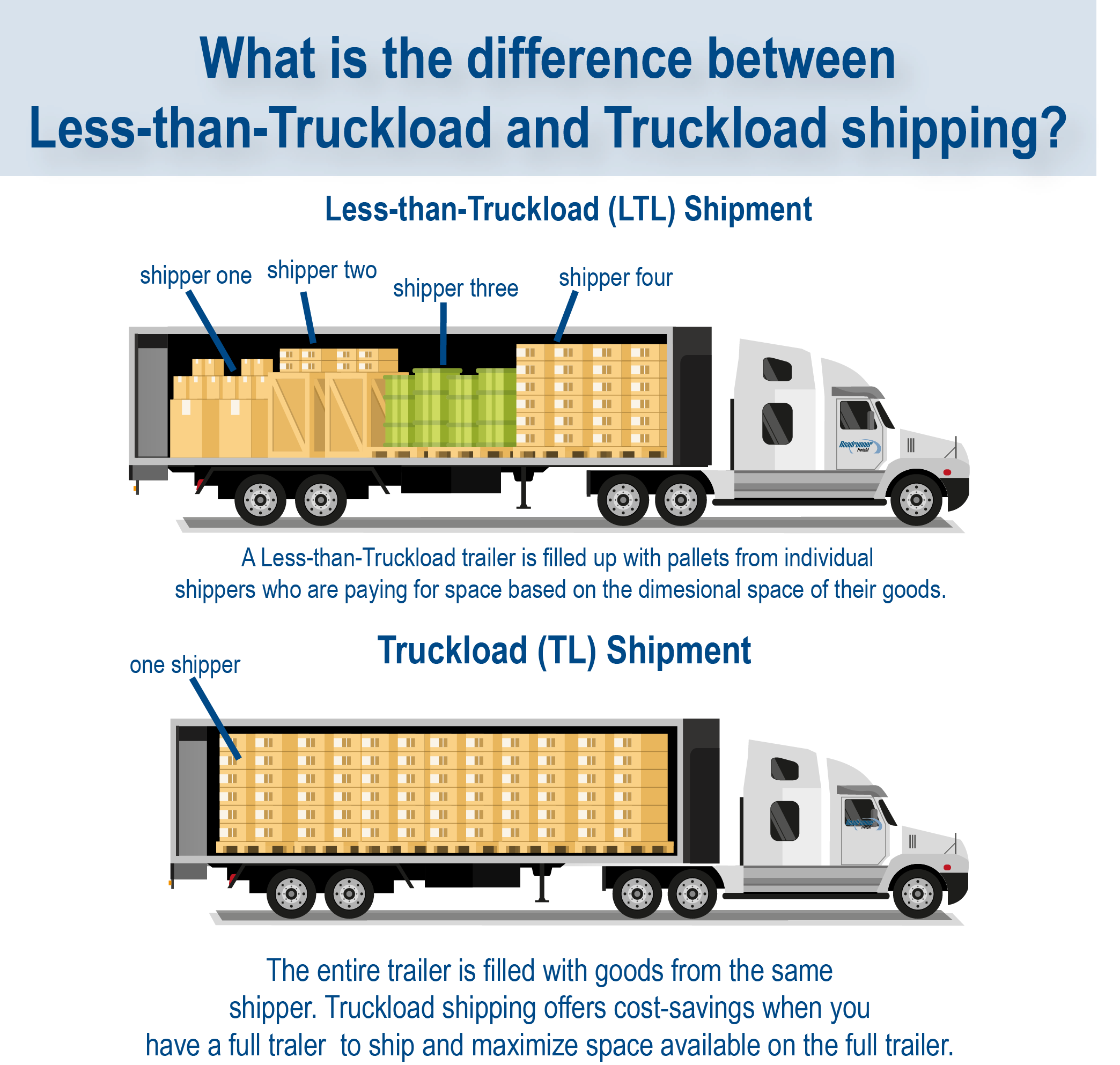
Pick up and Delivery (PUD) Trucks
City straight trucks are used for in the city to provide pickup and delivery services (PUD)
PUD vehicles are normally smaller than line-haul vehicles and are single units
A typical PUD truck has a cargo unit
that is 15 to 20 feet long
Motor Carrier Equipment pt 1
Line-haul vehicles – usually a tractor-trailer combination with 3 or more axles
A tractor-trailer combination with 5 axles is permitted on interstate system to haul a maximum of 80,000 lbs
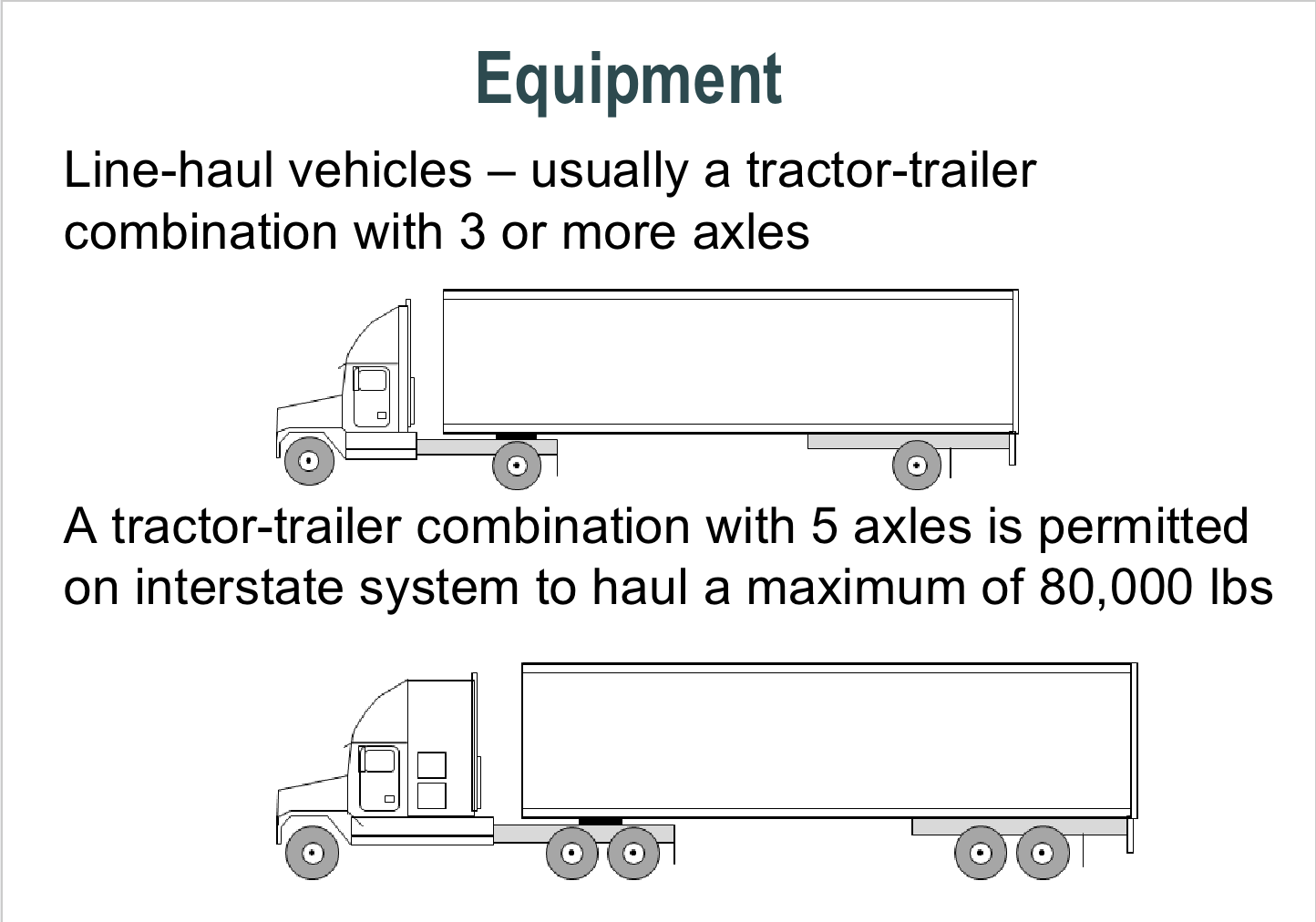
Motor Carrier Equipment pt 2
Specialized vehicles:
- Dry van (standard trailer with all sides enclosed)
- Open top (allows loading/unloading through the top)
- Flatbed (used to haul commodities like steel, lumber)
- Tank trailer
- Refrigerated trailed (reefer)

Advantages and Disadvantages to Motor Carriers
Advantages of Motor Carriers
Flexibility/Accessibility: Can serve virtually any location, including remote areas.
Speed for Short Hauls: For distances under 1,000 miles, trucks can pick up and deliver cargo faster and cheaper than air carriers.
Versatility: Flatbed trailers can transport standard ocean containers, allowing competition with railroads.
Disadvantages of Motor Carriers (based on general knowledge from ChatGPT)
Higher cost for long hauls compared to rail or water transport.
Limited capacity: Trucks carry less cargo than trains or ships.
Vulnerability to traffic, weather, and road conditions.
Rail Carriers
Companies that transport goods and sometimes passengers via trains on a network of railroad tracks, typically used for bulk, heavy, or long-distance shipments.
Each railroad serves a specific geographic region
Class 1 railroads
Class 1 railroads: companies with revenue of over $504M
In 1920 there were 186 Class 1 railroads. There are 7 now:
- BNSF (Burlington-Northern Santa Fe)
- Union Pacific
- CSX
- Norfolk Southern
- Canadian National Railway
- Canadian Pacific Kansas City
- Amtrak
Seven class 1 railroads generate 94% of railroad revenue
Regional Railroads
Regional railroads have revenue of $40-$504 Million
Local Railroad
Local railroads have revenue of under $40 Million
Goods carried by railroad
Goods carried by railroads are heavyweight low-value commodities or bulk products
Coal (hauled primarily by rail)
- Building and construction materials (lumber, pipes, metals, asphalt, paper, bricks)Farm products and food (grain, packaged and canned
food)Beverages (beer, wine, orange juice, soft drinks)
Liquids (ethanol, diesel fuel, gas, crude oil)
Chemicals (soda ash, sulfuric acid, plastic pellets)
Bulky items (transformers, military vehicles, machinery,
wind turbines)Vehicles (cars, trucks, SUVs, auto parts)
Intermodal containers
Rail Carriers Equipment
Basic unit of freight measure is carload
Carload varies in size and weight depending on the type of rail car used
In 2012 the average capacity per car is 102.7 tons
Trend is to increase car capacities, but bridge and track structure must handle the weight
Rail Car types
Boxcars (roofed, with sliding doors on the side) – used for general commodities
Hopper car with doors at the bottom – can have open top, or covered
Flat car (can be used for containers, lumber, military and construction equipment)
refrigerator car
Gondola car (open top, flat bottom)
Tank car
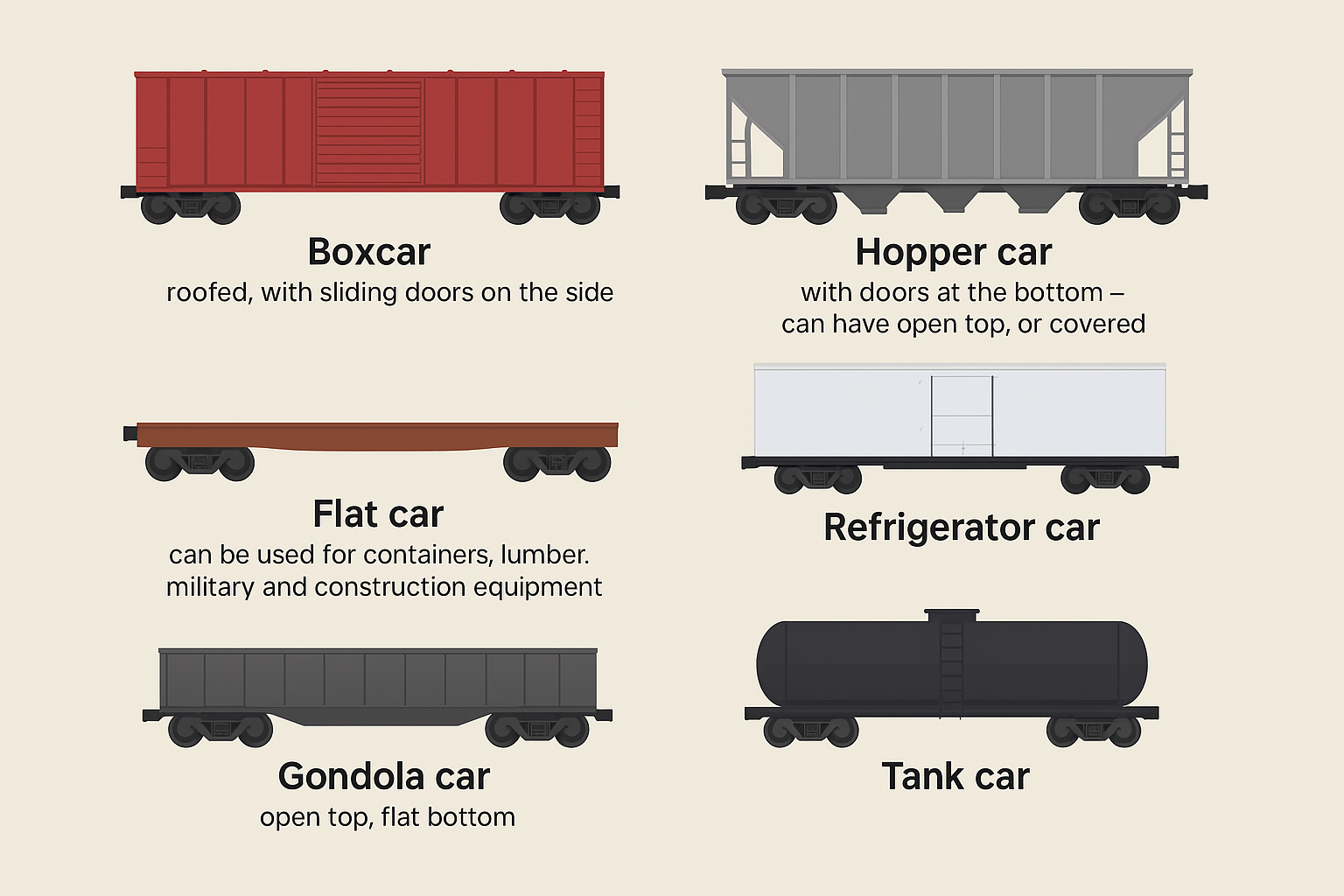
Advantages and Disadvantages to Railway
Advantages:
High capacity → lower cost per ton
Handles almost any commodity (variety of cars)
Flatcars carry containers → works with other transport
Disadvantages:
Fixed routes → less flexible
Slower than trucks/air
High infrastructure costs
Needs other transport for first/last mile
Intermodel Transportation
Trailer-on-Flatcar (TOFC) – Trucks’ entire trailers are loaded onto flat railcars. This lets trucks and rail work together; rail moves the long-haul part, trucks handle pick-up/delivery. Often called “piggyback service.”
Piggyback service is a distribution method that uses a combination of rail and truck transportation to move goods
Container-on-Flatcar (COFC) – Standard shipping containers are loaded directly onto flat railcars. This is the backbone of intermodal shipping, connecting ships, rail, and trucks efficiently.
Double stacking of containers allows for even higher efficiencies
Can be limited by heights of bridges (underpass clearances) and maximum carrying weights of bridges
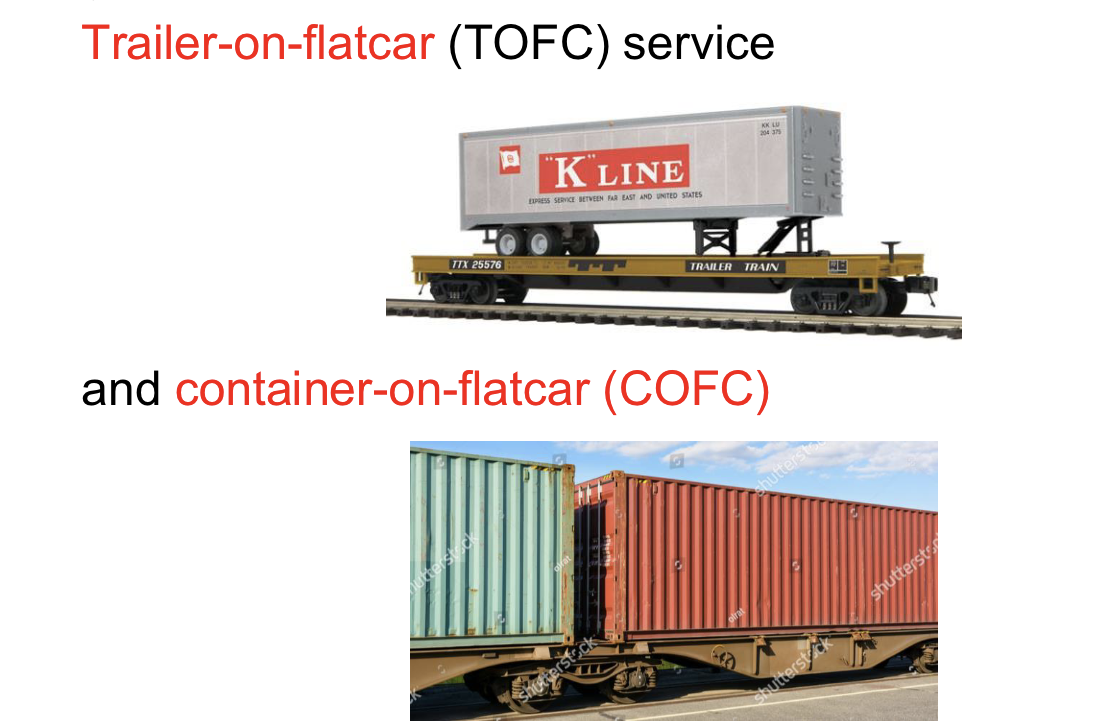
How do freight yards work
Trains arrive at major hubs.
Cars are disconnected and sorted by destination.
Cars going to the same direction are reassembled into new trains.
Cargo waits in the yard while trains are rebuilt → main reason rail is slower (avg. ~40 mph).
Simple Version:
Trains broken → cars sorted → rebuilt → cargo waits → slows delivery (~40 mph).
Water Carriers
Inexpensive (cheaper than air, truck, rail), but slow & inflexible. Includes inland waterway, coastal & inter-coastal, & deep-sea.
one of the two modes of transportation used in international trade when carrying cargo over the water.
Water Carriers Cost
Cost: Very low per ton → cheapest for heavy, bulky goods.
Speed: Very slow → slower than rail, truck, or air.
Twenty-foot Equivalent Unit (TEU) and Forty-foot Equivalent Unit (FEU)
Has same dimensions, except length is twice of
TEU (40-feet).
1 FEU = 2 TEU
Two FEU’s stacked on two
TEU’s (for a total of 6 TEU’s)

Major Container Shipping Companies (6)
Mediterranean Shipping Company (Switzerland, 800 vessels, 5.7 million TEUs, 20% of the market)
A.P. Moller-Maersk Group (Denmark, 675 vessels, 4.2 million TEUs, 15% of the market)
CMA CGM (France, 624 vessels, 3.6 million TEUs, 13% of the market)
COSCO (China, 490 vessels, 3.1 million TEUs, 11% of the market)
Hapag-Lloyd (Germany, 266 vessels, 2 million TEUs, 7% of the market)
ONE (Japan, 231 vessels, 1.8 million TEUs, 6% of the market)
Evolution of Shipping Containers
Early: ~1,000 TEU, converted ships
Fully Cellular: 2,300+ TEU, faster, dedicated
Panamax: ~4,500 TEU, fits old Panama Canal
Post-Panamax: 6,600–8,000 TEU, wider than Panama Canal
VLCS: 11,000–14,500 TEU, few ports can handle
Neo-Panamax: ~12,500 TEU, fits expanded Panama Canal
ULCV: 18,000–24,000 TEU, limited routes
Future (Malacca Max): 27,000–30,000 TEU, for high-volume route
**Bigger ships = lower cost per TEU (economies of scale), but require larger ports, deeper drafts, stronger infrastructure.
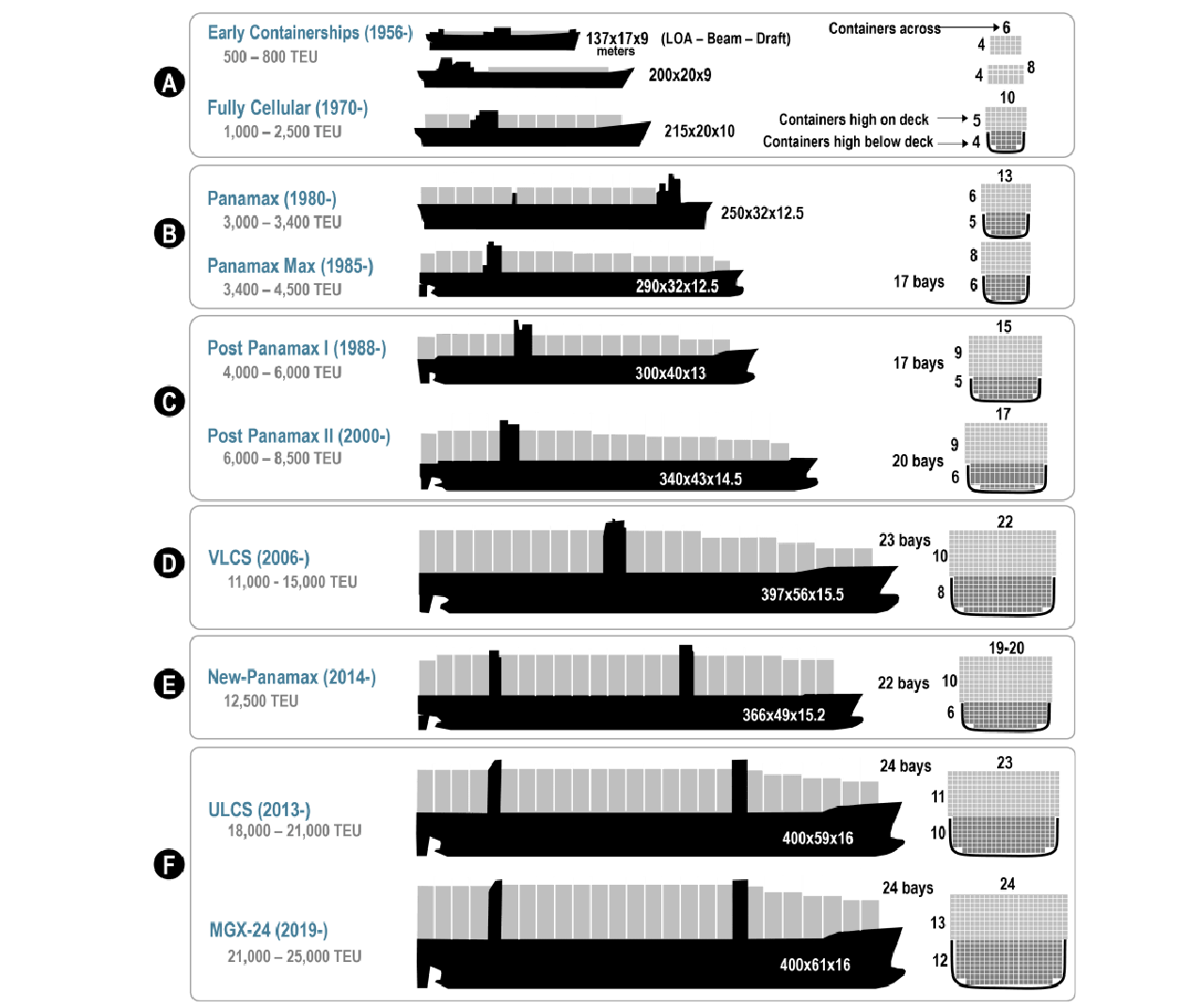
Advantages and Disadvantages of Water Carrier
Advantages:
Economies of scale: Larger ships = lower cost per container.
High capacity: Can carry thousands of TEUs at once.
Efficient for long distances: Ideal for international shipping (e.g., China → LA).
Disadvantages:
Slow speed: 15–20 knots (~17–23 mph), trips can take 16–21+ days.
Weather-dependent: Storms and rough seas can delay shipments.
Port limitations for very large ships: Only certain ports can handle VLCS/ULCV vessels.
Top US ports for water carriers
Los Angeles
Long Beach
New York
Savannah
Houston
Norfolk
Charleston
Oakland
Tacoma
Seattle
Baltimore
Miami
Philly
Port Evergaldes
Jacksonville
Mobile
Wilmington, DE
San Juan
Boston
New Orleans
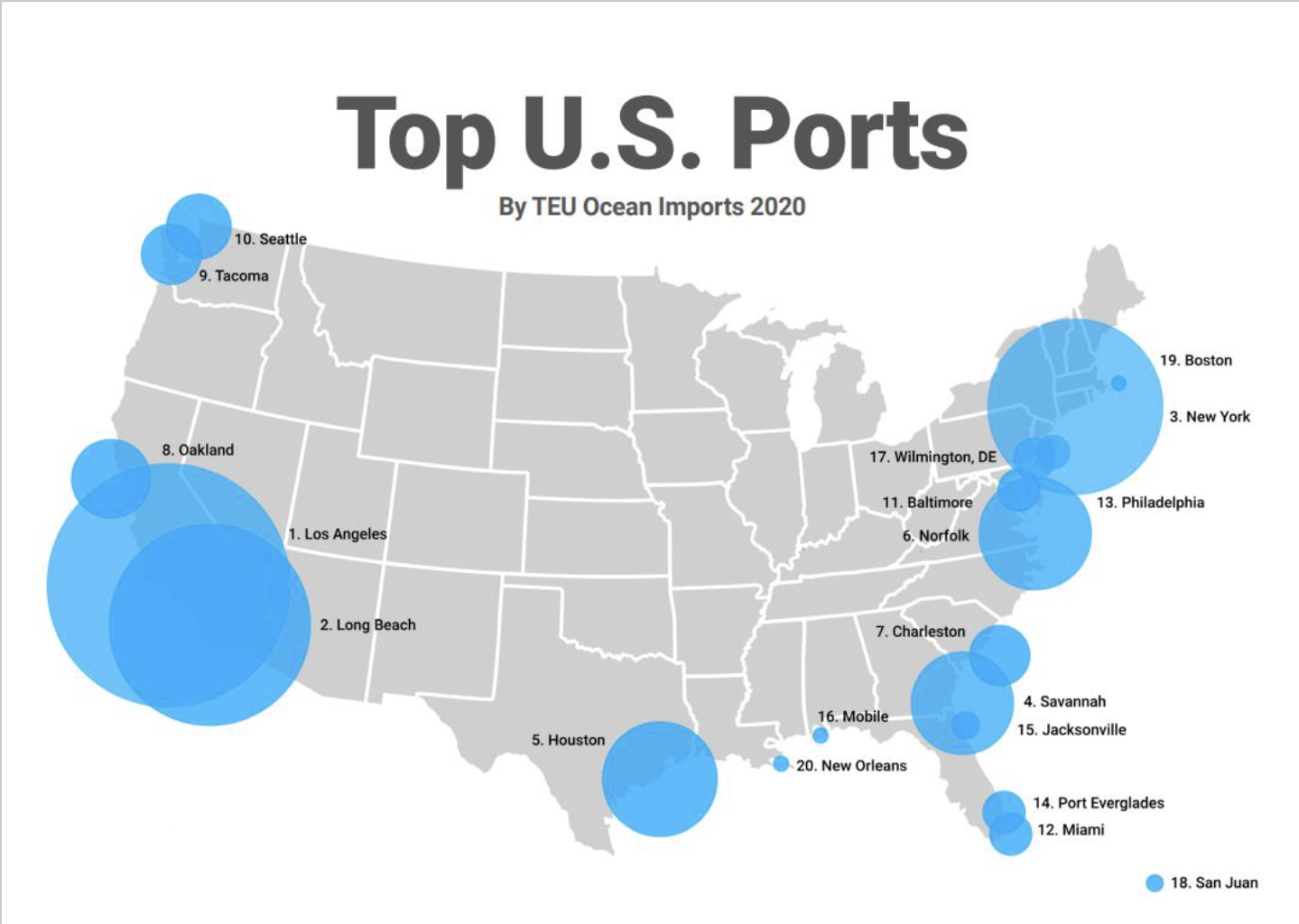
Dredging
removing dirt and debris from the bottom of shallow waters to make them more navigable by ships
Suez vs Panama Canal
Panama Canal: (this is all from chat)
Connects Atlantic ↔ Pacific.
Much shorter canal.
Smaller ship size limits (even after expansion) → Neo-Panamax (~12,500 TEU).
Cuts time for ships traveling between East Coast U.S. ↔ Asia or Caribbean ↔ Pacific.
Suez Canal:
Connects Mediterranean ↔ Red Sea (Europe ↔ Asia route).
No locks → handles much larger ships (ULCV up to ~20,000+ TEU).
Key route for Asia ↔ Europe.
Longer but allows massive ships that Panama cannot handle.
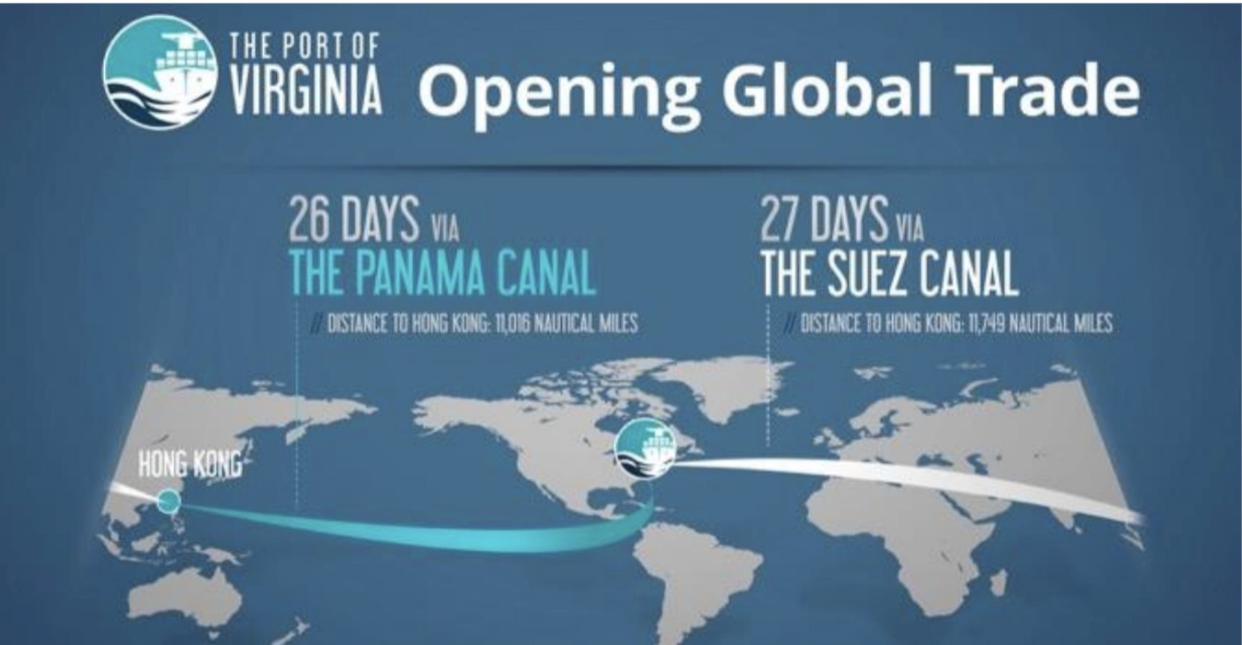
RoRo
RO-ROs or roll-on-roll-off cars, truck trailers & containers to be directly driven on & off the ship, without the use of cranes
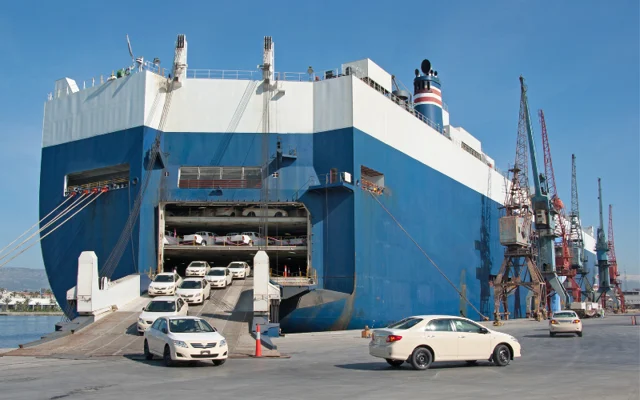
RoPax
RoPax – “RoRo + Passengers” – ships capable of carrying passengers combined with RoRo capability
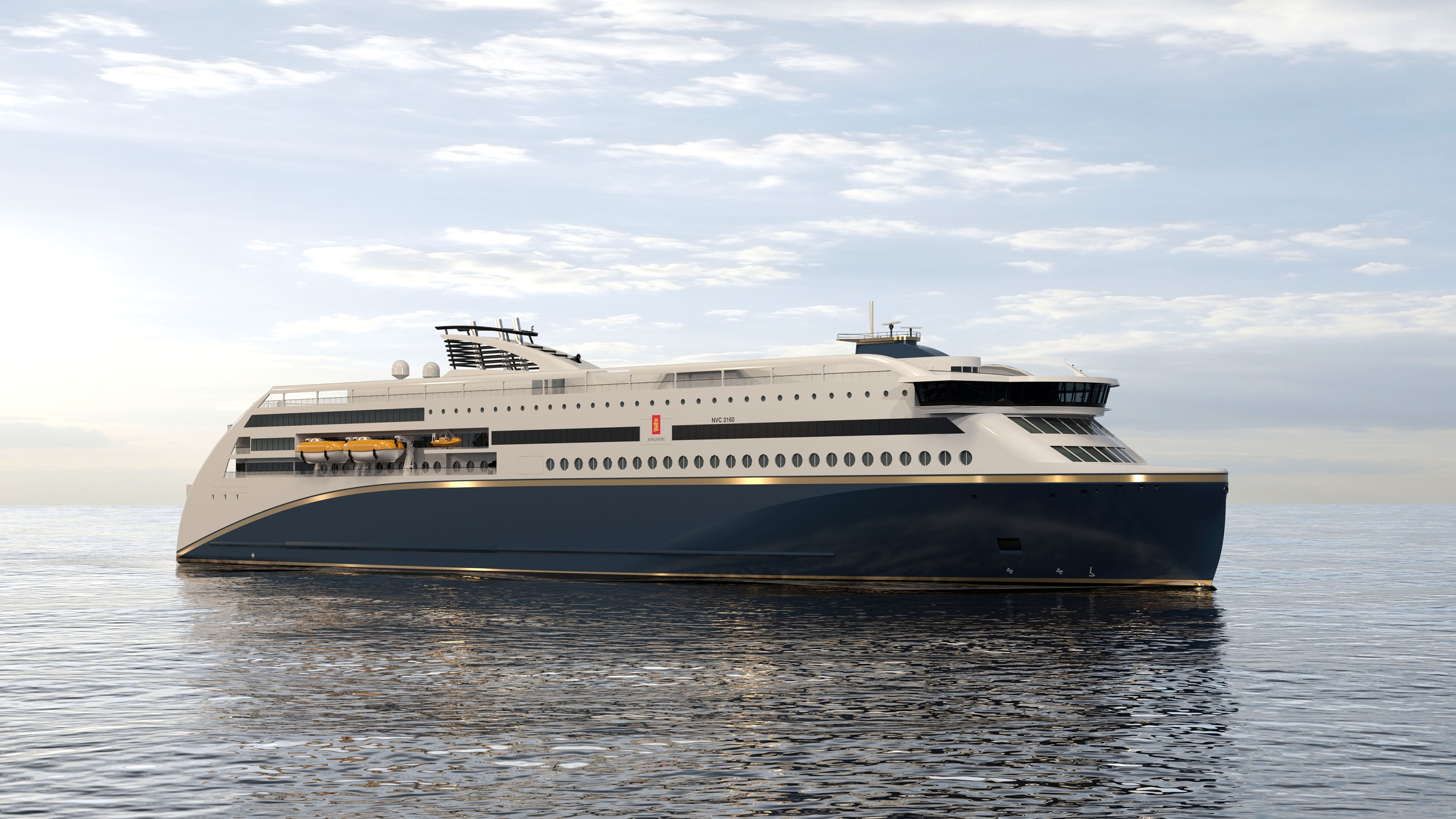
Consolidation warehouses
collect LTL shipments for transport in TL or CL quantities. Use of consolidation warehouses allows to realize transportation economies – consolidate and ship in TL or CL quantities.
Private Warehouses (idk if we need to know pros and cons)
Owned by the firm storing goods (majority of WH space in the US)
Pros:
Lower long-term cost
High control (labor, security, processes)
Choose location & equipment freely
Tax perks + can lease extra space
Cons:
High investment + financial risk
Low flexibility (hard to expand/move)
Only affordable for large firms
Insurance is harder/more costly
Public Warehouses
Owned by for profit orgs & leased out to other companies
Breakbulk- Breaks large shipments into customer-specific orders.
Includes repackaging, light assembly/customization, quality checks, material handling, and equipment/documentation support.
Offers short- or long-term storage.
Crossdocking
Receive → break down → repackage → ship out (to factories or stores).
Minimal storage (usually <24 hours).
Functions more like a distribution center, not a warehouse.
Warehousing
Goods are stored for days, weeks, or months.
Slower movement, more handling.
Higher inventory + storage costs.
Best for products needing buffer stock or seasonal demand.
Distribution Centers and how they operate
Fast-flow facilities, not storage dungeons like traditional warehouses.
Goods arrive, are sorted, processed, and shipped out quickly—often within hours.
Handle cross-docking, order picking, repackaging, labeling, and light assembly if needed.
Designed for speed, accuracy, and minimal inventory sitting around.
Rely on tech + automation to track every item (scanners, conveyors, WMS systems).
*chat answer
Center of Gravity Model for facility location
we did this hand out in class
What is SAP
An enterprise-wide information system
Developed by a German company SAP AG (founded in 1972 in Weinheim, Germany)
Enables the companies to manage business operations, reporting, and relationships with customers and suppliers from the single database
Is highly customizable – can be configured to fit any business
– Smithfield Foods
– Huntington Ingalls
– CSX
Major ERP Systems providers
– Oracle
– Microsoft Dynamics 365
– Sage
– Epicor
– Infor
ERP Models
SAP is very “modular” – the company does not have to install the full SAP system, it may choose to install some modules that do only certain business processes
• Financial modules:
– FI (Financial Accounting)
– CO (Controlling, Cost Accounting)
– IM (Investment Management)
– TR (Treasury)
– EC (Enterprise Control)
Other modules include:
– MM (Material Management)
– SD (Sales and Distribution)
– PP (Production Planning)
– PDM (Product Data Management)
– QM (Quality Management)
– PM (Plant Maintenance)
– SM (Service Management)
– HR (Human Resources)
– WM (Warehouse Management)
Client-server architecture
SAP uses a centralized client–server setup.
The server is the main brain — it stores data, processes requests, and checks transactions.
Clients (users/computers) connect to the server and ask it to do things with data.
These actions are called CRUD: Create, Read, Update, Delete.
ERP Data organization
All ERP systems keep in the central database
three types of data
Organizational data- structure of the company
Master data- the permanent info about people/things
Transaction data- the activities the business performs
SAP Organizational Data
client- the highest level; represents the entire SAP environment (one database for one company group)
client can consist of companie
company/company code- legal entity that reports financials separately.
plant- a location where goods are produced, stored, or distributed

Most commonly used SAP material master data
Raw Materials (ROH)
Semi-Finished goods (HALB)
Finished goods (FERT)
Trading goods (HAWA)- purchased from vendors and resold to customers
Storage Location
A place within a plant where materials are kept until needed
A plant can have multiple storage locations
Locations range from small bins to entire buildings in size
Purchasing process and its major steps
Purchasing activities can be managed at the client, company, or plant level.
Most purchasing actions occur within a company code.
The plant is the location where materials are received, called the receiving plant.
Another key level for purchasing is the storage location, where goods are physically stored.
